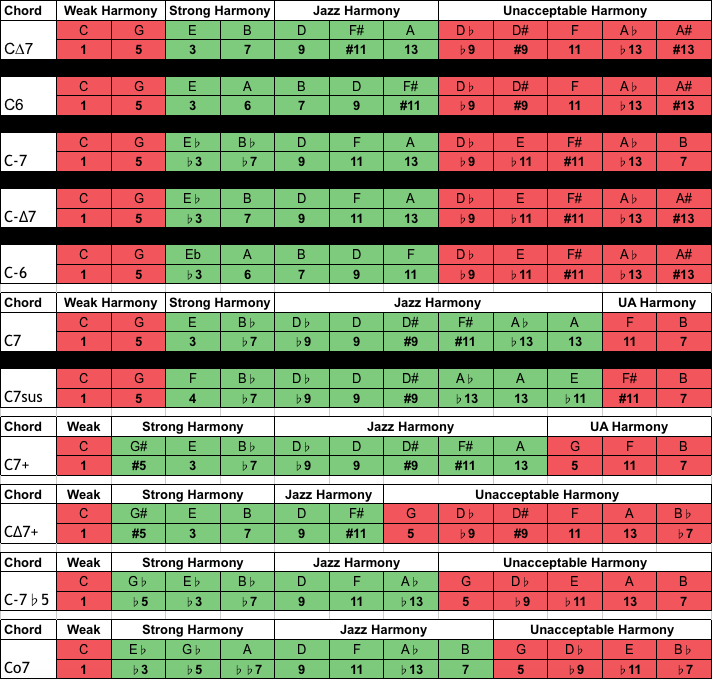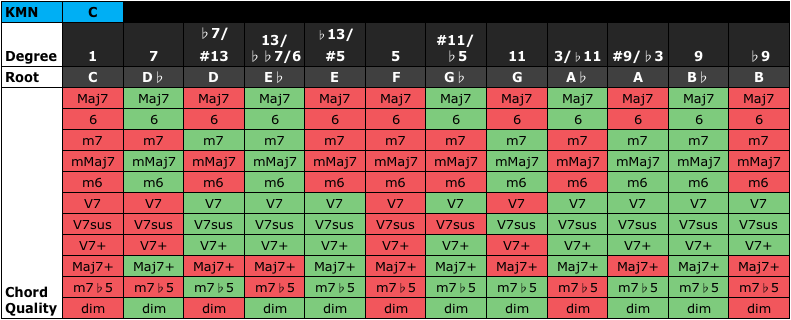Reharmonization
We began covering Reharmonization in the previous lesson. In this lesson we will further build and develop this topic, as well as review some of the content from the previous lesson.
Reharmonization = Chord substitution but for the whole chord progression
Reharmonization is used to:
- Make a song more ‘jazzy’ – that is, more harmonically and/or structurally complex;
- Personalise a song and make it your own (it’s almost like composing a brand new song, or a variation of an existing song).
So, generally, a song consists of a:
- Melody; and
- Chord progression
Reharmonization involves changing the melody or chords or both – but changing them with regard to certain rules or ideas.
To reharmonize a song you need to take two things into account:
- Harmony
- This depends on the interaction between the melody and the chords
- It depends on the quality of the chord (Maj, min, V7, etc.)
- Goal: To ensure the melody note is an ‘acceptable harmony’ over the chord
- Structure
- This refers to the movement of chords & bass-line
- It is NOT affected by the quality of the chord
- Goal: The structure must be logical.
- In practice this means that chords and bass-lines should move:
- by Fixed Intervals;
- by Diatonically;
- be Melody based.
The Overarching Goal of Reharmonization is:
- Change the chords and/or melody to ensure the melody is an ‘acceptable harmony’ over the chord.
- Change chords and bass-line so they move in a ‘structured way’.
Key Melody Note
The first thing you have to do when reharmonizing a song is to identify the Key Melody Note (KMN) of each bar:
- The KMN is harmonically the most important note in a bar – with all the other notes treated as passing notes (so NOT harmonically important)
- This is largely subjective, but the KMN tends to be the:
- Longest note in the bar
- First note in the bar
- Most repeated note in the bar
- A note played on-the-beat
- There may be more than one KMN in a bar, in which case:
- Account for both; or
- Look for the KMN in each half-bar (and so on)
- There may be no obvious KMN – e.g. a fast run of notes, in this case:
- Look at ALL or MOST of the notes in the bar
- Structure > Harmony – more on this later
Harmony
First let’s deal with the Harmony:
- Change the chord (tonality and quality) or KMN to ensure the KMN is an ‘acceptable harmony’ over the chord
- We have already learned in previous lessons that not all notes are equal. Some notes sound strong when played over a chord (Guide Tones), some notes sound pleasant and complement the sound of a chord (Available Tensions), while some notes sound weak and dissonant (Avoid Notes). Well, I’ve defined ‘acceptable harmony’ as ‘guide tones’ (3rd & 7th) plus ‘available tensions’. These are the notes that sound good over a particular chord. I have allocated every note into the following categories:
- Strong Harmony = Guide Tones
- Weak Harmony = Root & 5th
- Jazzy Harmony = Available Tensions
- Unacceptable Harmony = Unavailable Tensions/Avoid Notes
Acceptable Harmony = Guide Tones + Available Tensions
Below are the Acceptable Harmonies for a number of chord types.
Acceptable Harmonies

Ok, so now let’s do the same exercise but in reverse. Instead of taking a chord and finding all its acceptable harmonies, let’s take a note and find all the chords where that note is an acceptable harmony. Let’s use the note ‘C’.
- Below, all chords that create an ‘Acceptable Harmony’ with the Key Melody Note (C) are highlighted Green.
- The tonality/root of the chord is given in the row labelled ‘Root’
- The quality of the chord is given in the rows labelled ‘Chord Quality’
- The row labelled ‘Degree’ will tell you what degree the Key Melody Note is in relation to the chord.

You can use any of the chords coloured Green above to substitute for a chord when the key melody note of a bar is ‘C’.
Structure
Next let’s deal with the Structure:
- ‘Structure’ involves moving the chord and the bass-line in a ‘structured’ or ‘logical’ way, ignoring the quality of the chord.
- In reality this means moving the chords and bass-line in:
- Fixed intervals;
- Diatonically;
- Melody based; or
- Some other logical structure
- You can change chord inversions to create a smoother bass-line that doesn’t jump around too much
- The bass-line and chords can move in different ways as long as they are both ‘structured’
| Chromatic (Fixed Intervals) | E♭7 | D7 | D♭7 | CMaj7 |
| Coltrane (Fixed Intervals) | CMaj7 | G#Maj7 | EMaj7 | CMaj7 |
| Diatonic | F7 | E7 | D7 | CMaj7 |
| Melody Based | Melody: C Chord: Am7 | Melody: E Chord: CMaj7 | Melody: F Chord: D♭Maj7 | Melody: F Chord: Dm7 |
| Bassline (Pedal Point) | Chord: E♭6 Bass: C | Chord: D7 Bass: C | Chord: D♭Maj7 Bass: C | Chord: CMaj7 Bass: C |
| Bassline (Stepwise) | Chord: Em7 Bass: E | Chord: A7 Bass: E | Chord: Dm7 - G7 Bass: D - D | Chord: CMaj7 Bass: C |
Remember: The chords and bass-line can move independently and the chord quality doesn’t matter
Some Rules and Tips:
- Choose chords & melody that increase and then decrease tension
- To increase tension – use higher extensions and alterations (e.g.♭13)
- To decrease tension – use Guide Tones (3rd & 7th) & lower extensions (e.g. 9)
- On a long melody note or repeated melody note, move through a number of chords (this makes the melody note a kind of pedal point, which sounds great)
- While ideally we should have an acceptable harmony AND a logical structure, it is possible to have one without the other:
- You can have a weak harmony (root or 5th) if you have a strong structure (II-V); OR
- You can have a weak structure (no pattern) if you have a strong harmony (3rd or 7th)
- If the melody is a fast run of notes with no obvious ‘key melody note’
- Structure becomes more important than Harmony
- Bebop songs often use fast melody runs with strong II-V structured chord progressions
- Look at and consider all the notes in the bar
- Structure becomes more important than Harmony
Further study
To make your reharmonization sound even more professional and smooth:
Google Doc
Below is an embedded Google Doc which outlines all the possible reharmonization (substitute) chords for all chord types and all 12 note. You’re welcome to export it to Excel. To do this:
- Go to the Google Doc by clicking here
- Press ‘File’
- Select ‘Download as’
- Select ‘Microsoft Excel’
To see the above theory in action, please watch the below video.